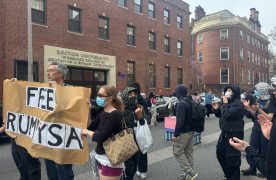Love or hate them – and there’s usually no middle ground — the U.S. News and World Report rankings are a big deal in higher education. So, congratulations for BU for their placement at spot 41 on this year’s list. But I was a bit dismayed to read the Daily Free Press’ coverage of this year’s Best Colleges list.
My concern wasn’t with the positive tone, nothing wrong with a little lording it over a crosstown rival. I was a little dismayed with the misleading description of what happened this year. BU did not actually “jump” in the 2013 rankings, nor did they “improve” in the rankings compared with last year. The formula for evaluating schools changed — as U.S. News does every year.
Comparing the same school, year-to-year based on their rank is as impossible as it is misleading. The horserace — with schools sliding up and down a ladder of merit — might be the way that U.S. News markets the rankings, but it need not be the way that journalists write about them. Comparing year-to-year rank of one particular school is an applies to grapefruits exercise.
Consider the case of school X that ranks 20 in 2012. Using the same inputs, (entering student SAT scores, faculty to student ratio, etc.) the same school based on the formula used in 2000 or 2011 could have ranked at 15 … or 25. Point is, when you change the criteria, the scores change. That churn on the scoreboard is good for selling magazines and for bragging, if you’re a dean that oversees a good score.
But this isn’t just about changing the way the rankings are discussed and covered in the paper. Schools spend lots of money — student’s, parent’s, government’s money — trying to achieve better results from U.S. News’s ever-changing ranking algorithm. Presidents are judged by it. Boards of trustees make hires based on it. Students pick schools after looking at it.
That’s why college presidents heavily lobby the editors at U.S. News. When I worked at U.S. News, I sat through many, many of these meetings where presidents from all types of schools tried to convince the editors that the furriness of school mascots, the width of campus parking spaces, or the length of a fight song should be weighed more heavily in the new ranking algorithm. Okay, maybe that’s a stretch, but you get the idea.
All of this is not to say that the rankings don’t serve a purpose. The data contained in the Best Colleges Guide is one of the most comprehensive assessments of what, for many people, will be the second-most expensive purchase of their lives, some $240,000. At the rate tuition is rising, college soon may be the most expensive thing you ever buy. But all that raw data is boring, while rankings catch eyeballs like flypaper. Just look at Buzzfeed.
But journalists aren’t public relations people, and they should bring a more skeptical eye to what is, in the end, a moving target.
Alex Kingsbury was an editor on various beats at U.S. News and World Report from 2003-2011, where he covered higher education, the war in Iraq, and the intelligence community.
This is an account occasionally used by the Daily Free Press editors to post archived posts from previous iterations of the site or otherwise for special circumstance publications. See authorship info on the byline at the top of the page.














Pingback: Letter to the Editor : The Capital Times
Last time I studied the numbers, BU accepted for admission an astonishing 66% of all applicants. And that of the accepted student pool, only 12% to 20% actually enrolled. The perception or even conclusion might be at that time was that BU was a fall back school. A last choice.
So, has anything changed since former President Westling incorrectly stated that BU accepted only 12% of applicants for admission and compared BU admission standards to Harvard’s?
Just asking.
52,532 students applied for admission this year
19,089 were accepted with another 5,053 wait listed
to fill 3,700 slots
= 36% acceptance rate
= 46% acceptance rate including the wait listed
= 24,142 total accepted to fill 3,700 slots
= 15% enrollment rate
yes there has been improvement but BU still must accept this many students in order to fill those slots which indicates it has trouble being a first choice school when it is more often than not, a “fall back”school.
Rounding the numbers: BU has 10,000 females and 6,500 male undergraduate students which presents gross Title IX compliance issues and perhaps adding a Division 1A caliber football program might begin attracting more American male students who would love attending nationally televised games against BCS Conference foes such as Notre Dame, Boston College, West Virginia and many more. And the school could make tens of millions in shared revenues which could further support building infrastructure and to provide more athletic opportunities for women without that sport needing to produce any revenues. Seriously which would excite a student more: a basketball game against SUNY Bighamton from the America East Conference or a game against Notre Dame? Would a student choose a football game on tv against a nationally ranked team or no football at all?
hmmmm.